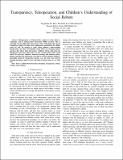Transparency, teleoperation, and children's understanding of social robots
Author(s)
Kory Westlund, Jacqueline Marie; Breazeal, Cynthia Lynn
DownloadBreazeal_Transparency, teleoperation.pdf (80.26Kb)
OPEN_ACCESS_POLICY
Open Access Policy
Creative Commons Attribution-Noncommercial-Share Alike
Terms of use
Metadata
Show full item recordAbstract
Teleoperation or Wizard-of-Oz control of social robots is commonly used in human-robot interaction (HRI) research. This is especially true for child-robot interactions, where technologies like speech recognition (which can help create autonomous interactions for adults) work less well. We propose to study young children's understanding teleoperation, how they conceptualize social robots in a learning context, and how this affects their interactions. Children will be told about the teleoperator's presence either before or after an interaction with a social robot. We will assess children's behavior, learning, and emotions before, during, and after the interaction. Our goal is to learn whether children's knowledge about the teleoperator matters (e.g., for their trust and for learning outcomes), and if so, how and when it matters most (e.g. at what age).
Date issued
2016-04Department
Massachusetts Institute of Technology. Personal Robots Group; Program in Media Arts and Sciences (Massachusetts Institute of Technology)Journal
2016 11th ACM/IEEE International Conference on Human-Robot Interaction (HRI)
Publisher
Institute of Electrical and Electronics Engineers (IEEE)
Citation
Westlund, Jacqueline M. Kory, and Cynthia Breazeal. “Transparency, Teleoperation, and Children’s Understanding of Social Robots.” 2016 11th ACM/IEEE International Conference on Human-Robot Interaction (HRI) (March 2016).
Version: Author's final manuscript
ISBN
978-1-4673-8370-7
ISSN
2167-2148